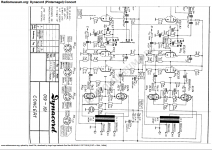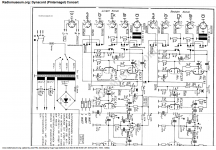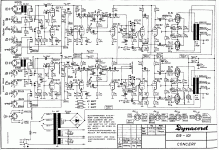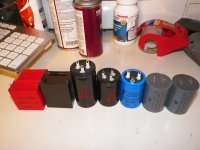a retired tv tech offered me about 200 tvs and radios to scrap, managed to recycle the crappy plastic tv sets, found a bunch of old tube radios and this beautifull amp.
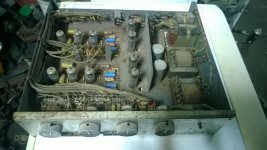
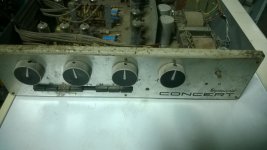
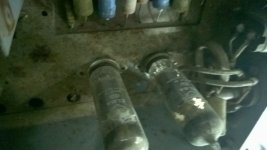
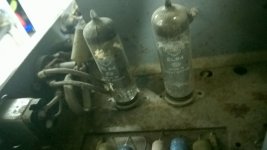
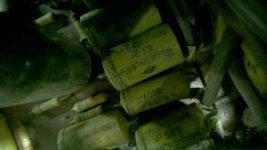
Its very very dirty and rusty, maybe i'll strip it, repaint, recap etc, maybe use the valves and transformers to build other thing, what do you think?
valves are all mullard ecc83 on the preamp sections and 4xel84 ,2 on each channel on push pull configuration.
the yellow caps look like wax type and some are cracked.
electrolytics look fine but maybe they are not
it is also missing a knob





Its very very dirty and rusty, maybe i'll strip it, repaint, recap etc, maybe use the valves and transformers to build other thing, what do you think?
valves are all mullard ecc83 on the preamp sections and 4xel84 ,2 on each channel on push pull configuration.
the yellow caps look like wax type and some are cracked.
electrolytics look fine but maybe they are not
it is also missing a knob
Last edited:
Strip the chassis down to the last bolt and then have it bead blasted. That will get rid of the rust. Then have it anodized or painted and rebuild it to original but with better components (caps, resistors, etc..)
Definitely worth getting it going to see how it sounds. If good then keep,it if not then use parts to transplant into something else. The chassis is worth re using and new knobs and faceplate wouldn't break the bank!
Caber 🙂
Caber 🙂
i can sand it easily, prime it and paint with automotive paint..i have acess to all the tools.. hard part is to remove every single part, all plugs and sockets etc are riveted not bolted, will be a pain to drill all the rivets without damaging anything...
should i replace the selenium rectifiers even if they be good?
as i dont have a capacitor tester would you advise me to replace all or only the cracked ones first and give it a go?
how about the 2 psu filter caps (dual section 32 +32)
i will keep you updated on the disassembly - cleanup etc. maybe ill start tomorrow
should i replace the selenium rectifiers even if they be good?
as i dont have a capacitor tester would you advise me to replace all or only the cracked ones first and give it a go?
how about the 2 psu filter caps (dual section 32 +32)
i will keep you updated on the disassembly - cleanup etc. maybe ill start tomorrow
Last edited:
Radio Museum has info. Apparently, the unit is rare. While matching the OEM knobs may prove impossible, a entire new set of nice knobs is not particularly difficult to track down.
It seems B+ is SS bridge rectified. Rebuilding to original, with better parts, is an option. However, simplifying to eliminate signal shaping circuitry is also an option.
If the phono section uses either AC heating or the "Cheap Charlie" method for DC heaters, add a proper, regulated, DC supply for those phono section tubes.
It seems B+ is SS bridge rectified. Rebuilding to original, with better parts, is an option. However, simplifying to eliminate signal shaping circuitry is also an option.
If the phono section uses either AC heating or the "Cheap Charlie" method for DC heaters, add a proper, regulated, DC supply for those phono section tubes.
I've rotated the schematic sections.
Replacing all of the electrolytic caps., which have dried out, is a matter of routine. Candidates for replacement signal caps. are 716P series "Orange Drops" and Soviet surplus K40 PIO parts.
The "finals" are full pentode. An obvious area for improvement is regulating O/P tube g2 B+
1960s SS diodes are noisy. Build a new bridge from 4X Cree C3D02060F Schottkys, provided they will fit. If space is a serious problem, use 4X UF4007s and snubber capacitors.
I see 100% AC heating. It is possible to have an acceptable hum level in a phono section that employs AC heating, but the challenge is daunting. Things begin with using Sovtek 12AX7LPS tubes, which are a genuine 7025 equivalent built with hum bucking, spiral wound, heaters. JMO, add a DC heater supply for the phono section.
I intensely dislike the 12AX7 triode in the "concertina" phase splitter role. Think hard about "borrowing" from the Dyanaco ST35, which uses 12DW7/7247 tubes.
In this day and age, a single set of I/Ps hard wired to the mag (phono) preamp is (IMO) best. Make all the other I/Ps line level. An inexpensive non-shorting Lorlin (UK) rotary switch handles selection of up to 6 sources.
Save the microphone trafos for some other project. Perhaps a new jack set of RCA females to take the place of the OEM DIN and XLR connectors is in order. That can be done with a nibbling tool and FR4 substrate PCB material to fill the opening created.
Replacing all of the electrolytic caps., which have dried out, is a matter of routine. Candidates for replacement signal caps. are 716P series "Orange Drops" and Soviet surplus K40 PIO parts.
The "finals" are full pentode. An obvious area for improvement is regulating O/P tube g2 B+
1960s SS diodes are noisy. Build a new bridge from 4X Cree C3D02060F Schottkys, provided they will fit. If space is a serious problem, use 4X UF4007s and snubber capacitors.
I see 100% AC heating. It is possible to have an acceptable hum level in a phono section that employs AC heating, but the challenge is daunting. Things begin with using Sovtek 12AX7LPS tubes, which are a genuine 7025 equivalent built with hum bucking, spiral wound, heaters. JMO, add a DC heater supply for the phono section.
I intensely dislike the 12AX7 triode in the "concertina" phase splitter role. Think hard about "borrowing" from the Dyanaco ST35, which uses 12DW7/7247 tubes.
In this day and age, a single set of I/Ps hard wired to the mag (phono) preamp is (IMO) best. Make all the other I/Ps line level. An inexpensive non-shorting Lorlin (UK) rotary switch handles selection of up to 6 sources.
Save the microphone trafos for some other project. Perhaps a new jack set of RCA females to take the place of the OEM DIN and XLR connectors is in order. That can be done with a nibbling tool and FR4 substrate PCB material to fill the opening created.
Attachments
The first thing you should do is check the primary windings of the output transformers for continuity.
If one has failed, a replacement is going to be difficult to find, and it will make a restore/rebuild doubtful value.
Of course, you can find alternative transformers, but you would then be looking to get a pair so that the channels match. At that point you are starting down the path of a new build.
If one has failed, a replacement is going to be difficult to find, and it will make a restore/rebuild doubtful value.
Of course, you can find alternative transformers, but you would then be looking to get a pair so that the channels match. At that point you are starting down the path of a new build.
Basically do what Eli and others said and change out the caps and the selenium bridge you talk about has to go..Now,I rebuild a lot of vintage tube gear and the best way to go on this is to put a 100% film cap power supply because you only have two electrolytics..The 32uf/32uf should use a 100uf/100uf if you stick with electrolytics..It's important you go higher in value because you have more noise on the line today from Plasma Tvs to computers that has to be filtered out,not to mention the higher dynamic CDs and LPs we play today compared to when the amp was built. Personally,I would go with a pair of 50uf at 500v panasonic poly film caps and you can glue those in..They are second from the left in picture next to the red 30uf wimas..The next 3 caps you see are electrolytics...Dual 100uf at 500v or dual 50uf at 500v JJs or a dual 100uf at 500v F&T..The last two gray ones are 35uf at 500v Poly film caps...a retired tv tech offered me about 200 tvs and radios to scrap, managed to recycle the crappy plastic tv sets, found a bunch of old tube radios and this beautifull amp.
View attachment 535740
View attachment 535741
View attachment 535742
View attachment 535743
View attachment 535744
Its very very dirty and rusty, maybe i'll strip it, repaint, recap etc, maybe use the valves and transformers to build other thing, what do you think?
valves are all mullard ecc83 on the preamp sections and 4xel84 ,2 on each channel on push pull configuration.
the yellow caps look like wax type and some are cracked.
electrolytics look fine but maybe they are not
it is also missing a knob
Put in Schottky diodes and those films caps and a combination of paper in oil and film cap couplers and you will be in heaven..I rebuilt the Telefunken version of this amp this was and it was very nice.
You can use the 35uf polys but why not go with the 50uf polys and have a little more reserve..Polys are much more efficient than electrolytics because they don't have the dielectric absorption issues and they are lower ESL by nature.
Attachments
Last edited:
Hello MichaelSamra from Michigan,
The Concert is giving you headaches I think.
I see a small bottle with Ibuprofen....
hugobarbedo,
Don't worry though,
Dynacord amps are good designed units.
Trafo's are very robust; I never had to replace one in my life.
Nice project.
The Concert is giving you headaches I think.
I see a small bottle with Ibuprofen....
hugobarbedo,
Don't worry though,
Dynacord amps are good designed units.
Trafo's are very robust; I never had to replace one in my life.
Nice project.
This is a NICE sounding amp once you get it in shape.
I would keep the rusty look though. Clean it of course, but keep the original patina. It has character... 😉
I would keep the rusty look though. Clean it of course, but keep the original patina. It has character... 😉
Back from a dormant forum period; family moves, different countries etc.
I remember those 1960 years, alot of these amps about with similiar configurations, concertina feeding into a nearly class A hot output stage. The tubes those days could take that 330V B+; but a selenium rectifier should be replaced with silicon; the problem is then one of excessive B+, but there are ways around it.. These amps ran hot; as with carbon composition components, a complete capacitor upgrade is vital. It appears good sounding Philips output transformers are used; those engineers knew their stuff. I WOULD NOT dump them.
richy
I remember those 1960 years, alot of these amps about with similiar configurations, concertina feeding into a nearly class A hot output stage. The tubes those days could take that 330V B+; but a selenium rectifier should be replaced with silicon; the problem is then one of excessive B+, but there are ways around it.. These amps ran hot; as with carbon composition components, a complete capacitor upgrade is vital. It appears good sounding Philips output transformers are used; those engineers knew their stuff. I WOULD NOT dump them.
richy
Rich,
Thanks for the "skinny" on the O/P "iron". A look said there's some heft, but the Philips point "seals the deal".
A "tallish" B+ rail is NBD. Use the Russian 6П14П-ЕВ (6p14p-ev), AKA EL84M, which is a genuine 7189 equivalent, as the O/P tubes. Provided they are in reasonable condition, the UOS EL84s currently in situ will fetch some money, in the marketplace.
Thanks for the "skinny" on the O/P "iron". A look said there's some heft, but the Philips point "seals the deal".
A "tallish" B+ rail is NBD. Use the Russian 6П14П-ЕВ (6p14p-ev), AKA EL84M, which is a genuine 7189 equivalent, as the O/P tubes. Provided they are in reasonable condition, the UOS EL84s currently in situ will fetch some money, in the marketplace.
Hugo,
In a previous post, I mentioned regulated g2 B+. In this lengthy thread, a discussion of a current implementation of the Maida setup can be found. Wade through the thread or (I strongly suggest) simply buy Tom's PCB and dispose of the matter.
In a previous post, I mentioned regulated g2 B+. In this lengthy thread, a discussion of a current implementation of the Maida setup can be found. Wade through the thread or (I strongly suggest) simply buy Tom's PCB and dispose of the matter.
If the ecc83's are <> base telefunken then you can easily sell them for $$$ and replace with Saratov/ Svetlana (or maybe even early 90's china) 12ax7. Sovtek 12AX7LPS work exceptionally well too of course 😉
Then again... you might just prefer to keep the telefunken 12ax7's - If they are flat plate then I would be tempted to keep them. There is something special with the flat plate telefunkens..
Small design tip on concertina phase splitter - try adding a high value grid stopper and even the 12ax7 will surprise... Unfortunately, this design has no grid stopper on the concertina... It is probably the very first "tweek" I would do after fixing all the obvious stuff mentioned up until now.
Also... I respectfully disagree with michaelsamra... I would be careful not to increase the B+ stock cap values by much. If its a stock 32uF cap then maybe go to 47uF if you must... but definitely not 100uF.
Then again... you might just prefer to keep the telefunken 12ax7's - If they are flat plate then I would be tempted to keep them. There is something special with the flat plate telefunkens..
Small design tip on concertina phase splitter - try adding a high value grid stopper and even the 12ax7 will surprise... Unfortunately, this design has no grid stopper on the concertina... It is probably the very first "tweek" I would do after fixing all the obvious stuff mentioned up until now.
Also... I respectfully disagree with michaelsamra... I would be careful not to increase the B+ stock cap values by much. If its a stock 32uF cap then maybe go to 47uF if you must... but definitely not 100uF.
Last edited:
Ok, I just re-read michaelsamra's post to not get in trouble.. I don't think he is recommending 100uF caps so you should be OK if you keep them not too high. Films are of course always ideal ... 😉
hi
thanks everyone for your precious advice!
today i replaced only the cracked caps, tested the windings of the transformers for shorts etc just to try the amp, plugged it in with a light bulb in series and it worked, it sounds great except for a huge hum that disappears when i turn it off and then i have 2 or 3 seconds of pure clean sound. the hum is independant of volume setting so probably bad filter caps no?
from the scrap pile and personal stock i have a bucket full of old mustards and some old ero capacitors, wima etc. i have to organize it all and see what i got.maybe they are worth fitting not to make the circuit too "modern".
if i replace the selenium rect. for silicon i have some big philips 100uf electrolytics and i guess they are going
i will try to play with what i have...
also on a side note the potentiometers are very scratchy maybe from the dust and grime. going now to the hardware store to buy wd40 for some preliminary cleaning.
also bought 2 gold plated rca jacks to make a more practical input and will fit it in a concealed place
thanks everyone for your precious advice!
today i replaced only the cracked caps, tested the windings of the transformers for shorts etc just to try the amp, plugged it in with a light bulb in series and it worked, it sounds great except for a huge hum that disappears when i turn it off and then i have 2 or 3 seconds of pure clean sound. the hum is independant of volume setting so probably bad filter caps no?
from the scrap pile and personal stock i have a bucket full of old mustards and some old ero capacitors, wima etc. i have to organize it all and see what i got.maybe they are worth fitting not to make the circuit too "modern".
if i replace the selenium rect. for silicon i have some big philips 100uf electrolytics and i guess they are going
i will try to play with what i have...
also on a side note the potentiometers are very scratchy maybe from the dust and grime. going now to the hardware store to buy wd40 for some preliminary cleaning.
also bought 2 gold plated rca jacks to make a more practical input and will fit it in a concealed place
Hi Hugobarbedo ! when you finish rebuilding this nice amp, please post some photos here...and pleased to see another fellow portuguese in this very good tube lovers forum...
Hi Hugo
Caps are not a "source" of hum. Do you have a digital multimeter? Please measure some voltages such as B+, anode, cathode, grids, etc and post them here.
Caps are not a "source" of hum. Do you have a digital multimeter? Please measure some voltages such as B+, anode, cathode, grids, etc and post them here.
N O W D 4 0 !!!!!!!!!!!!!!!!!!!!!!!!!!!!!!!!!!!!!!!!!!!!!!!!!!!!!!
N O W D 4 0 !!!!!!!!!!!!!!!!!!!!!!!!!!!!!!!!!!!!!!!!!!!!!!!!!!!!!!
Use a good quality cleaner for pots!!!
And using old caps; I don't know.
For initial test they can be OK.
For a longer period; use new ones.
The hum can be a result of bad power tubes.
But clean up your power supply.
Then the power stage.
Then the preamp stage.
Worth the effort.
N O W D 4 0 !!!!!!!!!!!!!!!!!!!!!!!!!!!!!!!!!!!!!!!!!!!!!!!!!!!!!!
Use a good quality cleaner for pots!!!
And using old caps; I don't know.
For initial test they can be OK.
For a longer period; use new ones.
The hum can be a result of bad power tubes.
But clean up your power supply.
Then the power stage.
Then the preamp stage.
Worth the effort.
- Status
- Not open for further replies.
- Home
- Amplifiers
- Tubes / Valves
- Found a vintage Dynacord Concert EL84 amp
